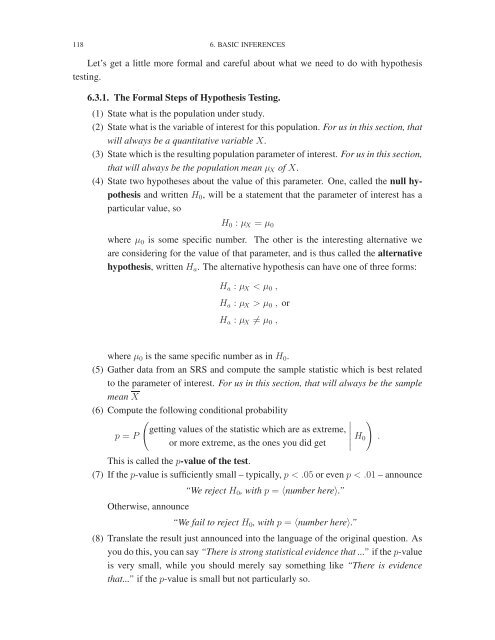Lies, Damned Lies, or Statistics- How to Tell the Truth with Statistics, 2017a
Lies, Damned Lies, or Statistics- How to Tell the Truth with Statistics, 2017a
Lies, Damned Lies, or Statistics- How to Tell the Truth with Statistics, 2017a
Create successful ePaper yourself
Turn your PDF publications into a flip-book with our unique Google optimized e-Paper software.
118 6. BASIC INFERENCES<br />
Let’s get a little m<strong>or</strong>e f<strong>or</strong>mal and careful about what we need <strong>to</strong> do <strong>with</strong> hypo<strong>the</strong>sis<br />
testing.<br />
6.3.1. The F<strong>or</strong>mal Steps of Hypo<strong>the</strong>sis Testing.<br />
(1) State what is <strong>the</strong> population under study.<br />
(2) State what is <strong>the</strong> variable of interest f<strong>or</strong> this population. F<strong>or</strong> us in this section, that<br />
will always be a quantitative variable X.<br />
(3) State which is <strong>the</strong> resulting population parameter of interest. F<strong>or</strong>usinthissection,<br />
that will always be <strong>the</strong> population mean μ X of X.<br />
(4) State two hypo<strong>the</strong>ses about <strong>the</strong> value of this parameter. One, called <strong>the</strong> null hypo<strong>the</strong>sis<br />
and written H 0 , will be a statement that <strong>the</strong> parameter of interest has a<br />
particular value, so<br />
H 0 : μ X = μ 0<br />
where μ 0 is some specific number. The o<strong>the</strong>r is <strong>the</strong> interesting alternative we<br />
are considering f<strong>or</strong> <strong>the</strong> value of that parameter, and is thus called <strong>the</strong> alternative<br />
hypo<strong>the</strong>sis, writtenH a . The alternative hypo<strong>the</strong>sis can have one of three f<strong>or</strong>ms:<br />
H a : μ X μ 0 , <strong>or</strong><br />
H a : μ X ≠ μ 0 ,<br />
where μ 0 is <strong>the</strong> same specific number as in H 0 .<br />
(5) Ga<strong>the</strong>r data from an SRS and compute <strong>the</strong> sample statistic which is best related<br />
<strong>to</strong> <strong>the</strong> parameter of interest. F<strong>or</strong> us in this section, that will always be <strong>the</strong> sample<br />
mean X<br />
(6) Compute <strong>the</strong> following conditional probability<br />
(<br />
)<br />
getting values of <strong>the</strong> statistic which are as extreme,<br />
p = P<br />
<strong>or</strong> m<strong>or</strong>e extreme, as <strong>the</strong> ones you did get ∣ H 0 .<br />
This is called <strong>the</strong> p-value of <strong>the</strong> test.<br />
(7) If <strong>the</strong> p-value is sufficiently small – typically, p

















